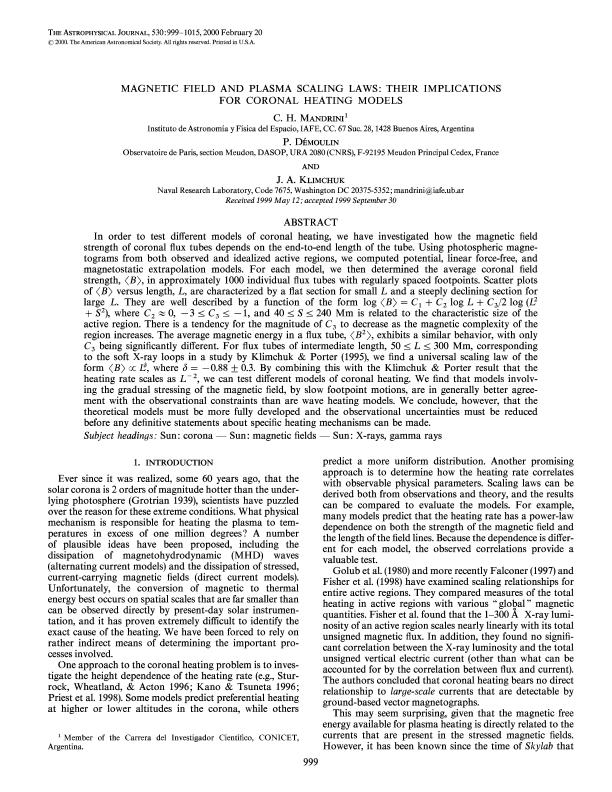Mostrar el registro sencillo del ítem
dc.contributor.author
Mandrini, Cristina Hemilse

dc.contributor.author
Démoulin, Pascal

dc.contributor.author
Klimchuk, James

dc.date.available
2017-08-17T20:28:14Z
dc.date.issued
2000-12
dc.identifier.citation
Mandrini, Cristina Hemilse; Démoulin, Pascal; Klimchuk, James; Magnetic field and plasma scaling laws: Their implications for coronal heating models; IOP Publishing; Astrophysical Journal; 530; 2; 12-2000; 999-1015
dc.identifier.issn
0004-637X
dc.identifier.uri
http://hdl.handle.net/11336/22626
dc.description.abstract
In order to test different models of coronal heating, we have investigated how the magnetic field strength of coronal flux tubes depends on the end-to-end length of the tube. Using photospheric magnetograms from both observed and idealized active regions, we computed potential, linear force-free, and magnetostatic extrapolation models. For each model, we then determined the average coronal field strength, langBrang, in approximately 1000 individual flux tubes with regularly spaced footpoints. Scatter plots of langBrang versus length, L, are characterized by a flat section for small L and a steeply declining section for large L. They are well described by a function of the form log img1.gif = C1 + C2 log L + C3/2 log(L2 + S2), where C2 ≈ 0, -3 ≤ C3 ≤ -1, and 40 ≤ S ≤ 240 Mm is related to the characteristic size of the active region. There is a tendency for the magnitude of C3 to decrease as the magnetic complexity of the region increases. The average magnetic energy in a flux tube, langB2rang, exhibits a similar behavior, with only C3 being significantly different. For flux tubes of intermediate length, 50 ≤ L ≤ 300 Mm, corresponding to the soft X-ray loops in a study by Klimchuk & Porter (1995), we find a universal scaling law of the form img1.gif ∝ Lδ, where δ = -0.88 ± 0.3. By combining this with the Klimchuk & Porter result that the heating rate scales as L-2, we can test different models of coronal heating. We find that models involving the gradual stressing of the magnetic field, by slow footpoint motions, are in generally better agreement with the observational constraints than are wave heating models. We conclude, however, that the theoretical models must be more fully developed and the observational uncertainties must be reduced before any definitive statements about specific heating mechanisms can be made.
dc.format
application/pdf
dc.language.iso
eng
dc.publisher
IOP Publishing

dc.rights
info:eu-repo/semantics/openAccess
dc.rights.uri
https://creativecommons.org/licenses/by-nc-sa/2.5/ar/
dc.subject
Magnetic Fields
dc.subject.classification
Astronomía

dc.subject.classification
Ciencias Físicas

dc.subject.classification
CIENCIAS NATURALES Y EXACTAS

dc.title
Magnetic field and plasma scaling laws: Their implications for coronal heating models
dc.type
info:eu-repo/semantics/article
dc.type
info:ar-repo/semantics/artículo
dc.type
info:eu-repo/semantics/publishedVersion
dc.date.updated
2017-08-16T18:05:47Z
dc.journal.volume
530
dc.journal.number
2
dc.journal.pagination
999-1015
dc.journal.pais
Reino Unido

dc.journal.ciudad
Londres
dc.description.fil
Fil: Mandrini, Cristina Hemilse. Consejo Nacional de Investigaciónes Científicas y Técnicas. Oficina de Coordinación Administrativa Ciudad Universitaria. Instituto de Astronomía y Física del Espacio. - Universidad de Buenos Aires. Facultad de Ciencias Exactas y Naturales. Instituto de Astronomía y Física del Espacio; Argentina
dc.description.fil
Fil: Démoulin, Pascal. Centre National de la Recherche Scientifique. Observatoire de Paris; Francia
dc.description.fil
Fil: Klimchuk, James. Spece Sciences División. Naval Research Laboratory; Estados Unidos
dc.journal.title
Astrophysical Journal

dc.relation.alternativeid
info:eu-repo/semantics/altIdentifier/url/http://iopscience.iop.org/article/10.1086/308398/meta
dc.relation.alternativeid
info:eu-repo/semantics/altIdentifier/doi/http://dx.doi.org/10.1086/308398
Archivos asociados
